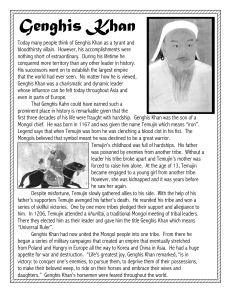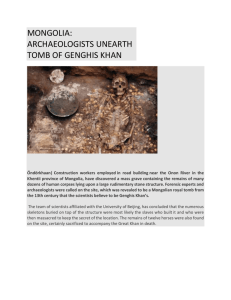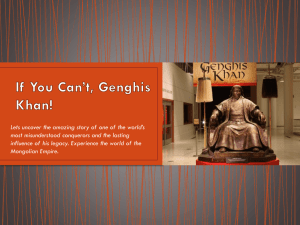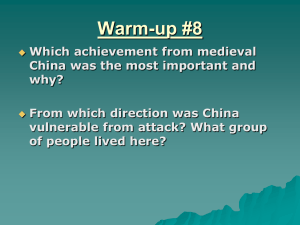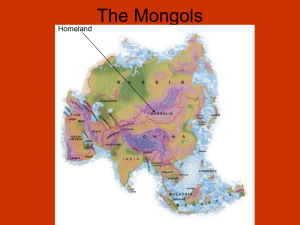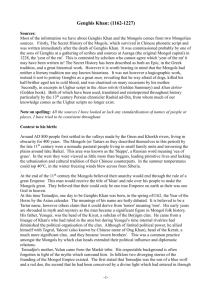Occupation: Supreme Khan of the Mongols Reign: 1206 to 1227
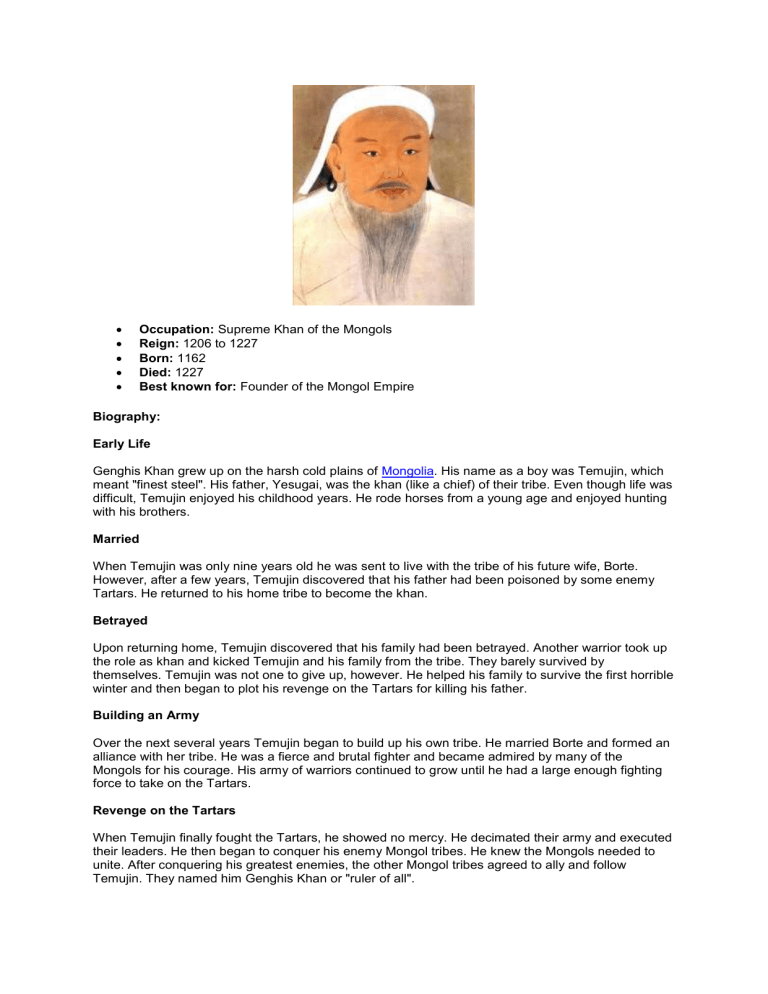
Occupation: Supreme Khan of the Mongols
Reign: 1206 to 1227
Born: 1162
Died: 1227
Best known for: Founder of the Mongol Empire
Biography:
Early Life
Genghis Khan grew up on the harsh cold plains of Mongolia . His name as a boy was Temujin, which meant "finest steel". His father, Yesugai, was the khan (like a chief) of their tribe. Even though life was difficult, Temujin enjoyed his childhood years. He rode horses from a young age and enjoyed hunting with his brothers.
Married
When Temujin was only nine years old he was sent to live with the tribe of his future wife, Borte.
However, after a few years, Temujin discovered that his father had been poisoned by some enemy
Tartars. He returned to his home tribe to become the khan.
Betrayed
Upon returning home, Temujin discovered that his family had been betrayed. Another warrior took up the role as khan and kicked Temujin and his family from the tribe. They barely survived by themselves. Temujin was not one to give up, however. He helped his family to survive the first horrible winter and then began to plot his revenge on the Tartars for killing his father.
Building an Army
Over the next several years Temujin began to build up his own tribe. He married Borte and formed an alliance with her tribe. He was a fierce and brutal fighter and became admired by many of the
Mongols for his courage. His army of warriors continued to grow until he had a large enough fighting force to take on the Tartars.
Revenge on the Tartars
When Temujin finally fought the Tartars, he showed no mercy. He decimated their army and executed their leaders. He then began to conquer his enemy Mongol tribes. He knew the Mongols needed to unite. After conquering his greatest enemies, the other Mongol tribes agreed to ally and follow
Temujin. They named him Genghis Khan or "ruler of all".
A Brilliant General
Genghis was a brilliant general. He organized his soldiers into groups of 1000 called "gurans". They trained each day on battlefield tactics and used smoke signals, flags, and drums to send messages quickly throughout the army. His soldiers were well-armed and were taught to fight and ride horses from a young age. They could control their horses using only their legs and fire deadly arrows while riding at full speed. He also used innovative tactics on the battlefield. Sometimes he would send in a small force and the have them retreat. When the enemy charged after the smaller force they would soon find themselves surrounded by a horde of Mongol warriors.
Leader
Genghis Khan was a strong leader. He was cruel and murderous to his enemies, but loyal to those who followed him. He introduced a written code of law called the Yasak. He promoted the soldiers who performed regardless of their background. He even expected his own sons to perform if they wanted to be leaders.
Conquests
After uniting the Mongol tribes, Genghis turned to the rich lands of the south. He first attacked the Xi
Xia people in 1207. It only took him two years to conquer the Xi Xia and get them to surrender.
In 1211, Genghis turned to the Jin Dynasty of China. He wanted to exact revenge over these people for their treatment of the Mongols. By 1215 he had captured Yanjing (Beijing) the capital city of the Jin and the Mongols ruled over the northern part of China .
Muslim Lands
Genghis wanted to establish trade with the Muslim lands to the west. He sent a trade delegation there to meet with their leaders. However, the governor of one of their cities had the men of the delegation killed. Genghis was furious. He took up the command of 200,000 warriors and spent the next several years destroying the cities to the west. He went as far as Eastern Europe destroying everything along the way. He was merciless, leaving no one alive.
The land to the west was called the Kwarizmian Empire. It was led by the Shah Ala ad-Din
Muhammad. The dynasty was brought to an end in 1221 when Genghis had both the Shah and his son executed.
Death
Genghis returned to China and died in 1227. No one is quite sure how he died, but many people think he was injured in a fall from his horse. He named his son Ogedei as his successor.
Interesting Facts about Genghis Khan
One of his greatest generals was Jebe. Jebe was once an enemy who shot Genghis in battle with an arrow. Genghis was so impressed he spared Jebe's life. Jebe's nickname became
"The Arrow".
Despite being one of the most powerful rulers in the world, he preferred to live in a tent called a yurt.
The Mongols used a similar system to the Pony Express to carry messages quickly throughout the empire.
His four favorite sons were Ogedei, Tolui, Chagatai, and Jochi. Tolui's son was Kublai
Khan who would conquer all of China and establish the Yuan Dynasty.
He once said that "conquering the world on horseback is easy; it is dismounting and governing that is hard."



